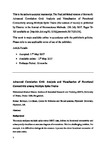Advanced Correlation Grid: Analysis and Visualisation of Functional Connectivity among Multiple Spike Trains
| dc.contributor.author | Masud, MS | |
| dc.contributor.author | Borisyuk, Roman | |
| dc.contributor.author | Stuart, EJ | |
| dc.date.accessioned | 2017-06-21T07:32:47Z | |
| dc.date.accessioned | 2017-06-21T08:00:14Z | |
| dc.date.available | 2017-06-21T07:32:47Z | |
| dc.date.available | 2017-06-21T08:00:14Z | |
| dc.date.issued | 2017-07-15 | |
| dc.identifier.issn | 0165-0270 | |
| dc.identifier.issn | 1872-678X | |
| dc.identifier.uri | http://hdl.handle.net/10026.1/9506 | |
| dc.description.abstract |
BACKGROUND: This study analyses multiple spike trains (MST) data, defines its functional connectivity and subsequently visualises an accurate diagram of connections. This is a challenging problem. For example, it is difficult to distinguish the common input and the direct functional connection of two spike trains. NEW METHOD: The new method presented in this paper is based on the traditional pairwise cross-correlation function (CCF) and a new combination of statistical techniques. First, the CCF is used to create the Advanced Correlation Grid (ACG) correlation where both the significant peak of the CCF and the corresponding time delay are used for detailed analysis of connectivity. Second, these two features of functional connectivity are used to classify connections. Finally, the visualization technique is used to represent the topology of functional connections. RESULTS: Examples are presented in the paper to demonstrate the new Advanced Correlation Grid method and to show how it enables discrimination between (i) influence from one spike train to another through an intermediate spike train and (ii) influence from one common spike train to another pair of analysed spike trains. COMPARISON WITH EXISTING METHODS: The ACG method enables scientists to automatically distinguish between direct connections from spurious connections such as common source connection and indirect connection whereas existing methods require in-depth analysis to identify such connections. CONCLUSIONS: The ACG is a new and effective method for studying functional connectivity of multiple spike trains. This method can identify accurately all the direct connections and can distinguish common source and indirect connections automatically. | |
| dc.format.extent | 78-101 | |
| dc.format.medium | Print-Electronic | |
| dc.language | en | |
| dc.language.iso | en | |
| dc.publisher | Elsevier BV | |
| dc.relation.replaces | http://hdl.handle.net/10026.1/9504 | |
| dc.relation.replaces | 10026.1/9504 | |
| dc.subject | Functional connectivity | |
| dc.subject | Correlation | |
| dc.subject | Analysis | |
| dc.subject | Visualisation | |
| dc.title | Advanced Correlation Grid: Analysis and Visualisation of Functional Connectivity among Multiple Spike Trains | |
| dc.type | journal-article | |
| dc.type | Journal Article | |
| plymouth.author-url | https://www.webofscience.com/api/gateway?GWVersion=2&SrcApp=PARTNER_APP&SrcAuth=LinksAMR&KeyUT=WOS:000404709700009&DestLinkType=FullRecord&DestApp=ALL_WOS&UsrCustomerID=11bb513d99f797142bcfeffcc58ea008 | |
| plymouth.volume | 286 | |
| plymouth.publication-status | Published | |
| plymouth.journal | Journal of Neuroscience Methods | |
| dc.identifier.doi | 10.1016/j.jneumeth.2017.05.016 | |
| plymouth.organisational-group | /Plymouth | |
| plymouth.organisational-group | /Plymouth/Faculty of Science and Engineering | |
| plymouth.organisational-group | /Plymouth/Faculty of Science and Engineering/School of Engineering, Computing and Mathematics | |
| plymouth.organisational-group | /Plymouth/REF 2021 Researchers by UoA | |
| plymouth.organisational-group | /Plymouth/REF 2021 Researchers by UoA/UoA11 Computer Science and Informatics | |
| plymouth.organisational-group | /Plymouth/Users by role | |
| plymouth.organisational-group | /Plymouth/Users by role/Academics | |
| plymouth.organisational-group | /Plymouth/Users by role/Researchers in ResearchFish submission | |
| dc.publisher.place | Netherlands | |
| dcterms.dateAccepted | 2017-05-11 | |
| dc.rights.embargodate | 2018-5-12 | |
| dc.identifier.eissn | 1872-678X | |
| dc.rights.embargoperiod | 18 months | |
| rioxxterms.versionofrecord | 10.1016/j.jneumeth.2017.05.016 | |
| rioxxterms.licenseref.uri | http://www.rioxx.net/licenses/under-embargo-all-rights-reserved | |
| rioxxterms.licenseref.startdate | 2017-07-15 | |
| rioxxterms.type | Journal Article/Review | |
| plymouth.funder | Cross-modality integration of sensory signals leading to initiation of locomotion::BBSRC | |
| plymouth.funder | Cross-modality integration of sensory signals leading to initiation of locomotion::BBSRC | |
| plymouth.funder | Cross-modality integration of sensory signals leading to initiation of locomotion::BBSRC | |
| plymouth.funder | Cross-modality integration of sensory signals leading to initiation of locomotion::BBSRC |


